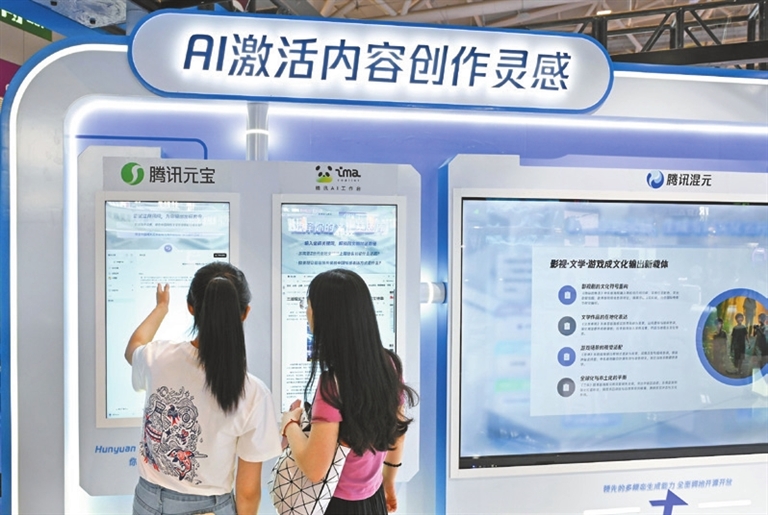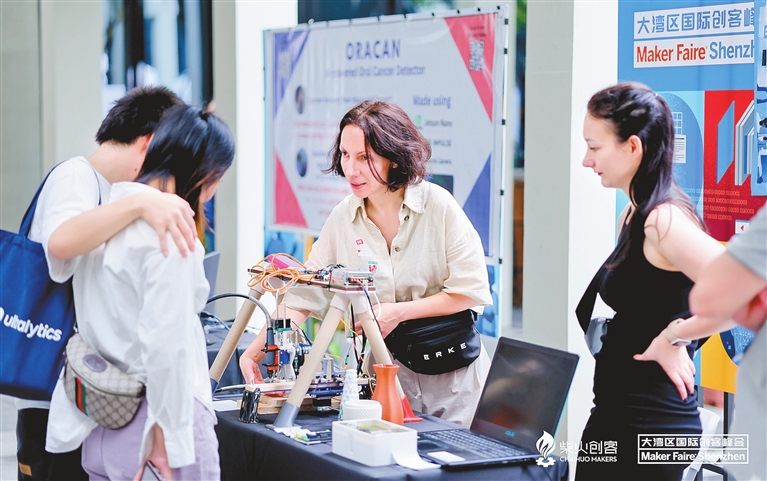




Luigi Gambardella szdaily@126.com THERE are cities that follow time and cities that generate it — cities that wait to see what the future will be and others that build it while it happens. Shenzhen belongs to the latter kind. Born from a stretch of sea and silence, it has learned to transform movement into meaning, technology into language, and vision into action until it became an operating system for creativity — a place where art, engineering, and consciousness merge into a single, self-updating flow. It no longer manufactures progress: it performs it, organizes it, composes it — a living symphony of circuits, ideas, and people. Once, ships left Shekou’s port loaded with goods. Today they leave carrying ideas and light. The cranes no longer lift containers but curiosity, and inside the Design Society — born from a collaboration between China Merchants Group and London’s Victoria & Albert Museum — a humanoid robot draws in response to the sounds of the room, its metal hand trembling as if it could feel the invisible heartbeat of the crowd. A curator, smiling faintly, whispers, “In Shenzhen, even art is software — always updating.” A few steps away, a digital garden grows and transforms as visitors walk through it: each movement generates a new leaf, each breath a fragment of landscape. It is not merely an installation — it is a self-portrait of the city itself, alive, learning, and recreating itself in an endless cycle of interaction and awareness. Here, creativity flows like electricity — invisible, indispensable, omnipresent — reminding us that the true purpose of technology is not to replace the human being, but to amplify wonder, enabling a new kind of collaboration between mind and world. The cultural engine of technology To understand Shenzhen, one must go beyond its skyline and walk through its maker spaces — those vibrant laboratories where tools hum like secular prayers and failure is not an error, but the first language of success. Every year, the Maker Faire Shenzhen becomes a temporary republic of creativity — a collective celebration where invention is a right and curiosity a form of citizenship. In 2024, more than 300 projects filled the halls: drones that plant trees, lamps that react to heartbeats, fabrics that move with touch. Among them, Jun, a 19-year-old engineering student, presented a 3D printer built entirely from recycled plastic. “It started as a hobby,” he said. “Now companies from Europe want to collaborate.” Jun represents a generation that no longer distinguishes between project and poetry, between engineering and imagination. In Shenzhen, innovation is not an occupation or an industrial sector — it is a collective reflex, a way of life that grows in garages and cafés, in shared studios and source codes, in the hands of young builders and the dreams of entrepreneurs. The city has made curiosity its civic infrastructure, turning invention into an urban instinct and experimentation into a cultural duty. What happens when imagination becomes infrastructure and creativity ceases to be decoration, but a strategy of civilization? Shenzhen answers with deeds: when creativity expands and organizes itself, it is no longer a cultural policy — it becomes collective intelligence, producing value, meaning, and identity. From the laboratory to the marketplace Shenzhen does not simply experiment: it turns imagination into economy. Across the design studios of Nanshan and the creative clusters of Shekou, ideas move naturally from sketch to prototype, from thought to object, and from concept to marketplace. In the creative labs of Tencent Games, engineers and artists work side by side, blending code and narrative, mathematics and emotion, creating experiences that belong not to a single sector but to a new aesthetics of connection. A local designer once explained it perfectly. “In Shenzhen, an idea isn’t art until it becomes experience.” By the end of 2023, the city counted 3,369 cultural enterprises above the designated-size threshold, with total revenue of 1.1 trillion yuan (US$155 billion). Between 2010 and 2022, the value of Shenzhen’s creative industries rose from 51.26 billion yuan to 246.2 billion yuan, accounting for nearly 9% of its GDP. Nationally, China’s cultural and related industries generated 19.14 trillion yuan in 2024, growing 7.1% year-on-year. But beyond the numbers lies a transformation of meaning: Shenzhen has proven that beauty can be infrastructure, a public resource that generates development, trust, and cohesion. When a city learns to code its own beauty, it changes the very definition of progress. Global connections Every metropolis interprets creativity in its own way: Los Angeles performs it, Milan designs it, and Shenzhen accelerates it. This acceleration has become a gravitational field that attracts talent, investment, and ideas from across the world. The 2025 China (Shenzhen) International Cultural Industries Fair hosted 2.2 million visitors, 6,280 delegations, and more than 120,000 products, turning the city into a living network of innovation and collaboration. Shenzhen, part of the UNESCO Creative Cities Network and officially recognized as a City of Design, has more than 6,000 enterprises and 100,000 professionals generating over 11 billion yuan in creative output each year. From AI art collectives to augmented and virtual reality studios, the city exports not products but possibilities, redefining “Made in China” as “Created in Shenzhen,” and then, something deeper still: “Imagined by humanity.” The other side of creativity Every light casts a shadow. As creativity becomes capital, some artists wonder whether inspiration can remain free, whether art can resist the logic of optimization and scale. Shenzhen never stops — it absorbs, reinvents, and reboots faster than any other city on Earth. And yet, within that velocity, there lies a quiet equilibrium. Each reinvention is not repetition but a rehearsal for the future, a continuous exercise in collective renewal. Perhaps every great city, sooner or later, stops building walls and begins to build mirrors — places where it can finally see its own reflection in the light it creates. Why it matters Shenzhen’s story no longer belongs only to China: it has become a global parable, a living map of humanity’s destiny in the age of artificial intelligence. It shows that the true frontier of innovation is not the machine that thinks, but the human being who thinks with the machine — not automation, but augmented imagination. For Europe — and for every society suspended between the nostalgia of the past and the necessity of the future — Shenzhen offers a subtle yet decisive lesson. The future will not be built by those who resist change, nor by those who surrender to it, but by those who converse with it, translating transformation into culture, empathy, and shared intelligence. Innovation, in the end, is not about computing power — it is about the bandwidth of the human heart, the capacity to transform data into meaning and meaning into belonging. As Shenzhen continues to update its creative code, it may soon become not only China’s innovation capital, but the world’s open-source consciousness — the laboratory where humanity learns to dream in real time, to create together, and to think of itself as a creative species. And so, Shenzhen keeps dreaming aloud — not of what tomorrow will bring, but of what humanity can become when imagination itself learns to think. (Luigi Gambardella is the president of ChinaEU, a Brussels-based association promoting digital cooperation between China and Europe.) | 
